
01 Mar Insider’s Guide to GSTR-4: Key Insights on Return Filing, Format, Eligibility, and Statutory Rules

Introduction:
Within the framework of Goods and Services Tax (GST), GSTR-4 emerges as a pivotal component, specifically tailored to cater to taxpayers enrolled in the Composition Scheme. This article endeavors to delve into the fundamental aspects of GSTR-4, elucidating its filing procedures, structure, eligibility prerequisites, and accompanying regulatory stipulations.
Understanding GSTR-4:
GSTR-4 assumes a critical role within the GST landscape, serving as a specialized return designated solely for composition dealers. Unlike conventional taxpayers obligated to furnish quarterly returns, individuals opting for the Composition Scheme are tasked with submitting a solitary return annually, encapsulated within the confines of GSTR-4. This singular filing obligation is due by the 30th of April following the culmination of the financial year.
Filing Deadlines:
The filing timeline for GSTR-4 adheres to a yearly rhythm. Taxpayers are mandated to ensure timely submission by the 30th of April subsequent to the conclusion of the relevant financial year. It’s noteworthy that prior to the fiscal year 2018-19, this obligation necessitated quarterly filings, subsequently replaced by CMP-08.
Eligibility Criteria:
The obligation to file GSTR-4 is exclusive to taxpayers enrolled in the Composition Scheme. Additionally, this mandate extends to entities availing themselves of the special composition scheme, as outlined in the CGST (Rate) notification number 2/2019, effective from the fiscal year 2019-20 onwards.
Revision Protocol:
Once lodged on the GSTN Portal, GSTR-4 remains immutable, devoid of any provision for subsequent revisions. Thus, exercising meticulous scrutiny and precision during the filing process becomes imperative to preempt the necessity for post-filing alterations.
Late Fees and Penalties:
Recent revisions have introduced a structured late fee regime, comprising a daily charge of Rs. 50, with a maximum limit capped at Rs. 2,000. In instances of zero tax liability, this ceiling is reduced to Rs. 500. Previously, failure to adhere to filing deadlines incurred a late fee of Rs. 200 per day, with an upper limit capped at Rs. 5,000.
In essence, comprehending the intricacies of GSTR-4 necessitates adept understanding and adherence to its prescribed guidelines. Through diligence and compliance, taxpayers can seamlessly fulfill their obligations within the GST framework, thereby ensuring regulatory compliance and averting avoidable penalties.


No Comments